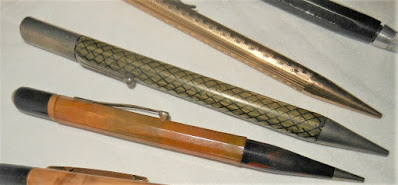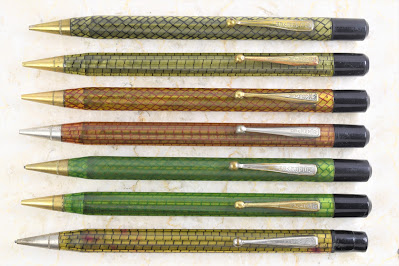This article has been included in The Leadhead's Pencil Blog Volume 7, now available here.
If you don't want the book but you enjoy the article, please consider supporting the Blog project here.
When one of these came my way recently, I was eager to circle back around:
Even the fuzziest of online auction pictures showed that clear window mid-barrel to show where the spare leads are kept, so I knew exactly what it was:
“Tripp Barr.” These pencils come in two sizes, and as is the case with my new addition, the caps are often missing. Here’s all of the examples that have come my way over the years:
That turquoise one at bottom is really nice, and it’s in far better condition than average for these. Let’s back up and try that again: “. . . so I knew exactly what it was:”
I haven’t written about the Tripp Barr since 2012, when I posted two articles which appear in Volume 1. In the first, the main point of the article was to marvel at how crazy people seem to go for the Tripp-Barr when they show up in online auctions (Volume 1, page 228). I revisited the brand a couple months later, when a short version of the all-transparent barrel surfaced in the pencils I acquired from the estate of Edgar Nichols (inventor of the Tri-Point and proprietor of the Nichols Products Corporation - see Volume 1, page 293):
Information often comes fast and furious when I post an article about an obscure brand like this one, and I’m writing follow up articles every few months. The Tripp-Barr has been a much longer fishing trip - since I threw out a baited hook in 2012, that bobber’s just been sitting dead in the water with nary a ripple for nearly ten years.
In September 2020, I logged into the administrator’s area of the blog to clean out junk comments (the spammers tend to play when the blog is inactive). The Tripp-Barr bobber was gone, and the tip of the pole was touching the water, since Terrence A. Beverley had posted a comment to my Tripp-Barr article:
“The Tripp Barr pencil was patented in 1933 by Edmund R. Barany, the paternal grandfather of my wife,” Terrence wrote. “We have the original patent documents which are beautiful works in themselves. The Tripp Barr was carried by Macy's and sold for $1.47 with the slogan ‘Loaded with lead for the year ahead.’
“We have a Tripp Barr brochure and a full newspaper page showing the Macy's ad. The pencil was manufactured and sold in two configurations. One being a two-part solid shaft and the other being a three-part shaft with one of the parts known as an indicator window. To gain access to the spare LED, remove the cap and remove the eraser. Tilt the pencil and the spare LEDs will slide out.”
Well! Send that stuff along, I said, and let’s answer a few questions!
I included Edmund Barany’s patent in American Writing Instrument Patents Volume 2: 1922-1945, but I never associated Barany with the Tripp-Barr because what makes the Tripp-Barr stand out – the center visible window – doesn’t appear in his drawings.
The patent is consistent with the first part of the family history Terrence passed on: Edmund R. Barany applied for his patent June 10, 1933, and it was issued on May 15, 1934 as number 1,959,226. The patent number also appears in the brochure Terrence mentioned, which he was kind enough to share with us:
Terrence also forwarded a copy of that Macy’s advertisement, which appeared in The New York Herald on April 1, 1934:
Yes, the Tripp Barr was marketed at Macy’s – but not exclusively. Hutzler Brothers, a local jeweler in Baltimore, also advertised the pencils in The Baltimore Sun on May 5, 1934:
The Tripp Barr disappears from circulation within a year . . . at least, in the form we know. Another bit of information Terrence supplied provided a clue. He mentioned the family was in possession of original patent documents, and he forwarded one of them to me:
Recall above the “Other Patents Pending” reference in that brochure? Since these drawings don’t match the only pencil patent I found issued to Barany, these drawings must have been prepared in connection with another patent application which was never granted . . . and that cap, with its star-shaped metal insert to create a lead magazine within the barrel, reminded me of something else . . .
A while back Rob Bader sold me a few trade catalogs, which I’ve scanned and at some point will contribute to the PCA library (projects, projects, projects). One of these catalogs is from David Kahn, Inc., makers of the Wearever, and I dated it to 1935 or 1936, since one page in the catalog advertises the “Treasure,” complete with the same 1935 photograph from “Mutiny on the Bounty” from the “Treasure Chest” set I wrote about in 2018 (see Volume 5, page 140).
Another page in the catalog illustrates the “new” Wearever “Visible Pencil” . . .
That’s right. Edmund Barany’s design for a pencil with a cap including a star shaped insert might have been intended for his Tripp Barr line, but it wound up on David Kahn’s Wearever “Visible Pencil.”
There’s more.
While I was researching this story, I ran across an online auction that I just missed by a month or so; the auction title included the words “Tripp Barr.” I zoomed in on the terrible pictures, and by process of elimination I figured out which one bore that obscure name. It was another all-translucent barrel model, with a telling difference:
I immediately recognized the diagonal brick pattern on the barrel . . . it shows up on another page of my David Kahn catalog, illustrating the Wearever Visible “Year ‘Round” pencil:
Early in my collecting days I had fun chasing down the diagonal and horizontal versions of Kahn’s “Year ‘Round” in the cataloged colors of black, red and green:
Incidentally, it drove me a little crazy to find two varieties of the clip on these, one with a pronounced hump and larger ball, the other one straight with a smaller one – since the catalog artwork seems to show something in between the two, I’m thinking they were using whatever was on hand at the time. The bottom example has a clip marked “Onward,” another Kahn brand, another thing rubbing my OCD tendencies a bit raw.
“Year ‘Round” . . . sort of reminiscent of the tagline on that Tripp Barr brochure, isn’t it? “Loaded with lead for the year ahead.”
I am sure to a moral certainty that David Kahn, Inc. manufactured the Tripp Barr, but according to Terrence the brand was solely Edmund Barany’s baby; if that’s true, David Kahn made the pencils for Barany – it was not a Kahn production.
So where did the name “Tripp Barr” come from? Unfortunately, the family’s oral history didn’t preserve that information. Barany’s son, from whom Terrance got what information he was able to provide, passed away in 2019. However, I do have a theory.
Edmund Barany was a very prolific inventor with dozens of patents to his credit, but his dabbling in the pencil business was a very brief one. Earlier in his career he invented and patented numerous innovations in flashlights, including one which was near and dear to my heart: a flashlight with a second button, so with the flashlight on you could easily flick it on and off to communicate in Morse code:
My grandfather had one of these I used to play with as a kid – that’s the same grandfather whose Autopoints inspired my Dad to start collecting pencils and in turn inspired me. I remember how effective this device could be, not so much in signaling Morse code as annoying Gramps on weekend sleepover visits, after nights of drinking too many sugary “Little Hugs” over games of Yahtzee.
“Tripp Barr” would make sense as a cute riff on “trip bar” - a mechanical device which would hold a circuit open or closed in electrical applications. Perhaps the name was Barany’s tongue-in-cheek homage to his earlier career as a flashlight inventor.
Edmund Barany wasn’t finished as an inventor after his brief foray into pencils. Terrence reports that his best-known invention was still to come: the reader head on those reel-to-reel sound recording devices. He also shared a picture of Edmund, at work later in his career:
I wonder . . .
. . . if there was ever a desk pencil version of the Tripp Barr?























No comments:
Post a Comment